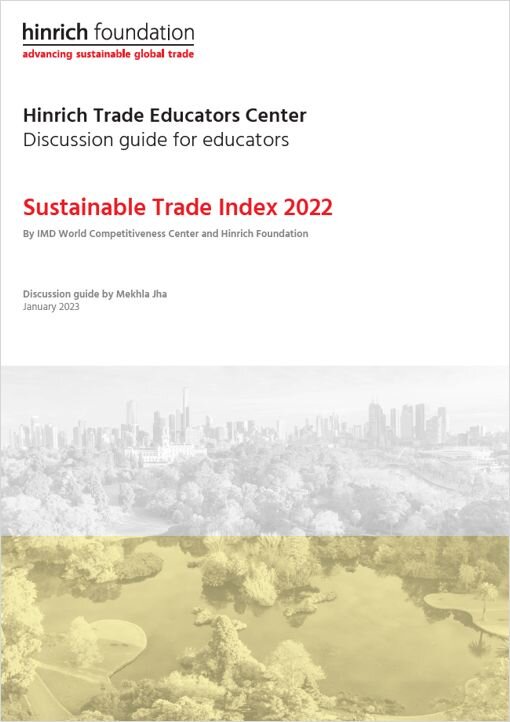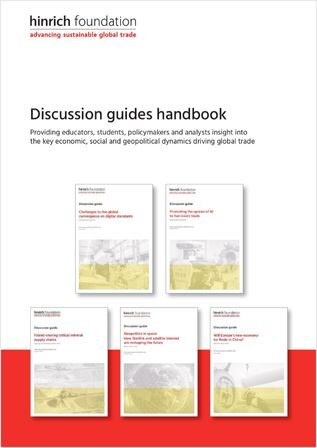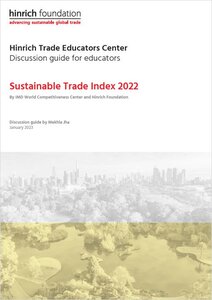MOST RECENT
EXPLORE THESE TOPICS
EXPLORE THESE TOPICS
EXPLORE THESE TOPICS
EXPLORE THESE TOPICS
Select trade topic
WTO
The Deglobalization Myth: How Asia’s supply chains are changing
Governments in major economies have rolled out new policies to reduce their high dependency on China for strategic goods. While the resulting changes are poised to challenge China’s status as "the world’s factory", the country is not sitting idly by and is itself trying to expand and deepen its position in the global geoeconomic architecture. For Beijing, industrial upgrading is not only about technological leadership and reducing dependence on foreign input but also about modernizing traditional manufacturing At present, the US does not sufficiently understand how China positions itself in the global semiconductor value chain, what China is doing, or to what end. If the US can better understand Chinas capabilities and positioning, ... it will conclude that the current semiconductor contest is not simply one for the cutting-edge of the value chains downstream, but for the entire value chain, write Nathan Picarsic and Emily de la Bruyère, co-founders of Horizon Advisory, a strategic consultancy with a focus on China policy.
Read more
Governments in major economies have rolled out new policies to reduce their high dependency on China for strategic goods. While the resulting changes are poised to challenge China’s status as "the world’s factory", the country is not sitting idly by and is itself trying to expand and deepen its position in the global geoeconomic architecture. For Beijing, industrial upgrading is not only about technological leadership and reducing dependence on foreign input but also about modernizing traditional manufacturing.
Read more
The Deglobalization Myth: How Asia’s supply chains are changing
Governments in major economies have rolled out new policies to reduce their high dependency on China for strategic goods. While the resulting changes are poised to challenge China’s status as "the world’s factory", the country is not sitting idly by and is itself trying to expand and deepen its position in the global geoeconomic architecture. For Beijing, industrial upgrading is not only about technological leadership and reducing dependence on foreign input but also about modernizing traditional manufacturing.
Due to its industrial capabilities, cost efficiency, and comprehensive supply chain infrastructure, China will continue to shape this period of re-globalization characterized by systemic competition. Beijing will make the process as costly as possible for its rivals as the country competes with both emerging and developed economies. How the country leverages its manufacturing power will matter tremendously for any diversification efforts and the global economy, writes Max J. Zenglein of MERIS
WTO
The Deglobalization Myth: How Asia’s supply chains are changing
Governments in major economies have rolled out new policies to reduce their high dependency on China for strategic goods. While the resulting changes are poised to challenge China’s status as "the world’s factory", the country is not sitting idly by and is itself trying to expand and deepen its position in the global geoeconomic architecture. For Beijing, industrial upgrading is not only about technological leadership and reducing dependence on foreign input but also about modernizing traditional manufacturing At present, the US does not sufficiently understand how China positions itself in the global semiconductor value chain, what China is doing, or to what end. If the US can better understand Chinas capabilities and positioning, ... it will conclude that the current semiconductor contest is not simply one for the cutting-edge of the value chains downstream, but for the entire value chain, write Nathan Picarsic and Emily de la Bruyère, co-founders of Horizon Advisory, a strategic consultancy with a focus on China policy.
Read more
Governments in major economies have rolled out new policies to reduce their high dependency on China for strategic goods. While the resulting changes are poised to challenge China’s status as "the world’s factory", the country is not sitting idly by and is itself trying to expand and deepen its position in the global geoeconomic architecture. For Beijing, industrial upgrading is not only about technological leadership and reducing dependence on foreign input but also about modernizing traditional manufacturing.
Read more
The Deglobalization Myth: How Asia’s supply chains are changing
Governments in major economies have rolled out new policies to reduce their high dependency on China for strategic goods. While the resulting changes are poised to challenge China’s status as "the world’s factory", the country is not sitting idly by and is itself trying to expand and deepen its position in the global geoeconomic architecture. For Beijing, industrial upgrading is not only about technological leadership and reducing dependence on foreign input but also about modernizing traditional manufacturing.
Due to its industrial capabilities, cost efficiency, and comprehensive supply chain infrastructure, China will continue to shape this period of re-globalization characterized by systemic competition. Beijing will make the process as costly as possible for its rivals as the country competes with both emerging and developed economies. How the country leverages its manufacturing power will matter tremendously for any diversification efforts and the global economy, writes Max J. Zenglein of MERIS
WTO
The Deglobalization Myth: How Asia’s supply chains are changing
Governments in major economies have rolled out new policies to reduce their high dependency on China for strategic goods. While the resulting changes are poised to challenge China’s status as "the world’s factory", the country is not sitting idly by and is itself trying to expand and deepen its position in the global geoeconomic architecture. For Beijing, industrial upgrading is not only about technological leadership and reducing dependence on foreign input but also about modernizing traditional manufacturing At present, the US does not sufficiently understand how China positions itself in the global semiconductor value chain, what China is doing, or to what end. If the US can better understand Chinas capabilities and positioning, ... it will conclude that the current semiconductor contest is not simply one for the cutting-edge of the value chains downstream, but for the entire value chain, write Nathan Picarsic and Emily de la Bruyère, co-founders of Horizon Advisory, a strategic consultancy with a focus on China policy.
Read more
Governments in major economies have rolled out new policies to reduce their high dependency on China for strategic goods. While the resulting changes are poised to challenge China’s status as "the world’s factory", the country is not sitting idly by and is itself trying to expand and deepen its position in the global geoeconomic architecture. For Beijing, industrial upgrading is not only about technological leadership and reducing dependence on foreign input but also about modernizing traditional manufacturing.
Read more
The Deglobalization Myth: How Asia’s supply chains are changing
Governments in major economies have rolled out new policies to reduce their high dependency on China for strategic goods. While the resulting changes are poised to challenge China’s status as "the world’s factory", the country is not sitting idly by and is itself trying to expand and deepen its position in the global geoeconomic architecture. For Beijing, industrial upgrading is not only about technological leadership and reducing dependence on foreign input but also about modernizing traditional manufacturing.
Due to its industrial capabilities, cost efficiency, and comprehensive supply chain infrastructure, China will continue to shape this period of re-globalization characterized by systemic competition. Beijing will make the process as costly as possible for its rivals as the country competes with both emerging and developed economies. How the country leverages its manufacturing power will matter tremendously for any diversification efforts and the global economy, writes Max J. Zenglein of MERIS
WTO
The Deglobalization Myth: How Asia’s supply chains are changing
Governments in major economies have rolled out new policies to reduce their high dependency on China for strategic goods. While the resulting changes are poised to challenge China’s status as "the world’s factory", the country is not sitting idly by and is itself trying to expand and deepen its position in the global geoeconomic architecture. For Beijing, industrial upgrading is not only about technological leadership and reducing dependence on foreign input but also about modernizing traditional manufacturing At present, the US does not sufficiently understand how China positions itself in the global semiconductor value chain, what China is doing, or to what end. If the US can better understand Chinas capabilities and positioning, ... it will conclude that the current semiconductor contest is not simply one for the cutting-edge of the value chains downstream, but for the entire value chain, write Nathan Picarsic and Emily de la Bruyère, co-founders of Horizon Advisory, a strategic consultancy with a focus on China policy.
Read more
Governments in major economies have rolled out new policies to reduce their high dependency on China for strategic goods. While the resulting changes are poised to challenge China’s status as "the world’s factory", the country is not sitting idly by and is itself trying to expand and deepen its position in the global geoeconomic architecture. For Beijing, industrial upgrading is not only about technological leadership and reducing dependence on foreign input but also about modernizing traditional manufacturing.
Read more
The Deglobalization Myth: How Asia’s supply chains are changing
Governments in major economies have rolled out new policies to reduce their high dependency on China for strategic goods. While the resulting changes are poised to challenge China’s status as "the world’s factory", the country is not sitting idly by and is itself trying to expand and deepen its position in the global geoeconomic architecture. For Beijing, industrial upgrading is not only about technological leadership and reducing dependence on foreign input but also about modernizing traditional manufacturing.
Due to its industrial capabilities, cost efficiency, and comprehensive supply chain infrastructure, China will continue to shape this period of re-globalization characterized by systemic competition. Beijing will make the process as costly as possible for its rivals as the country competes with both emerging and developed economies. How the country leverages its manufacturing power will matter tremendously for any diversification efforts and the global economy, writes Max J. Zenglein of MERIS
WTO
The Deglobalization Myth: How Asia’s supply chains are changing
Governments in major economies have rolled out new policies to reduce their high dependency on China for strategic goods. While the resulting changes are poised to challenge China’s status as "the world’s factory", the country is not sitting idly by and is itself trying to expand and deepen its position in the global geoeconomic architecture. For Beijing, industrial upgrading is not only about technological leadership and reducing dependence on foreign input but also about modernizing traditional manufacturing At present, the US does not sufficiently understand how China positions itself in the global semiconductor value chain, what China is doing, or to what end. If the US can better understand Chinas capabilities and positioning, ... it will conclude that the current semiconductor contest is not simply one for the cutting-edge of the value chains downstream, but for the entire value chain, write Nathan Picarsic and Emily de la Bruyère, co-founders of Horizon Advisory, a strategic consultancy with a focus on China policy.
Read more
Governments in major economies have rolled out new policies to reduce their high dependency on China for strategic goods. While the resulting changes are poised to challenge China’s status as "the world’s factory", the country is not sitting idly by and is itself trying to expand and deepen its position in the global geoeconomic architecture. For Beijing, industrial upgrading is not only about technological leadership and reducing dependence on foreign input but also about modernizing traditional manufacturing.
Read more
The Deglobalization Myth: How Asia’s supply chains are changing
Governments in major economies have rolled out new policies to reduce their high dependency on China for strategic goods. While the resulting changes are poised to challenge China’s status as "the world’s factory", the country is not sitting idly by and is itself trying to expand and deepen its position in the global geoeconomic architecture. For Beijing, industrial upgrading is not only about technological leadership and reducing dependence on foreign input but also about modernizing traditional manufacturing.
Due to its industrial capabilities, cost efficiency, and comprehensive supply chain infrastructure, China will continue to shape this period of re-globalization characterized by systemic competition. Beijing will make the process as costly as possible for its rivals as the country competes with both emerging and developed economies. How the country leverages its manufacturing power will matter tremendously for any diversification efforts and the global economy, writes Max J. Zenglein of MERIS
Governments in major economies have rolled out new policies to reduce their high dependency on China for strategic goods. While the resulting changes are poised to challenge China’s status as "the world’s factory", the country is not sitting idly by and is itself trying to expand and deepen its position in the global geoeconomic architecture. For Beijing, industrial upgrading is not only about technological leadership and reducing dependence on foreign input but also about modernizing traditional manufacturing.
Read more
The Deglobalization Myth: How Asia’s supply chains are changing
Governments in major economies have rolled out new policies to reduce their high dependency on China for strategic goods. While the resulting changes are poised to challenge China’s status as "the world’s factory", the country is not sitting idly by and is itself trying to expand and deepen its position in the global geoeconomic architecture. For Beijing, industrial upgrading is not only about technological leadership and reducing dependence on foreign input but also about modernizing traditional manufacturing.
Due to its industrial capabilities, cost efficiency, and comprehensive supply chain infrastructure, China will continue to shape this period of re-globalization characterized by systemic competition. Beijing will make the process as costly as possible for its rivals as the country competes with both emerging and developed economies. How the country leverages its manufacturing power will matter tremendously for any diversification efforts and the global economy, writes Max J. Zenglein of MERIS
WTO
The Deglobalization Myth: How Asia’s supply chains are changing
Governments in major economies have rolled out new policies to reduce their high dependency on China for strategic goods. While the resulting changes are poised to challenge China’s status as "the world’s factory", the country is not sitting idly by and is itself trying to expand and deepen its position in the global geoeconomic architecture. For Beijing, industrial upgrading is not only about technological leadership and reducing dependence on foreign input but also about modernizing traditional manufacturing At present, the US does not sufficiently understand how China positions itself in the global semiconductor value chain, what China is doing, or to what end. If the US can better understand Chinas capabilities and positioning, ... it will conclude that the current semiconductor contest is not simply one for the cutting-edge of the value chains downstream, but for the entire value chain, write Nathan Picarsic and Emily de la Bruyère, co-founders of Horizon Advisory, a strategic consultancy with a focus on China policy.
Read more
Governments in major economies have rolled out new policies to reduce their high dependency on China for strategic goods. While the resulting changes are poised to challenge China’s status as "the world’s factory", the country is not sitting idly by and is itself trying to expand and deepen its position in the global geoeconomic architecture. For Beijing, industrial upgrading is not only about technological leadership and reducing dependence on foreign input but also about modernizing traditional manufacturing.
Read more
The Deglobalization Myth: How Asia’s supply chains are changing
Governments in major economies have rolled out new policies to reduce their high dependency on China for strategic goods. While the resulting changes are poised to challenge China’s status as "the world’s factory", the country is not sitting idly by and is itself trying to expand and deepen its position in the global geoeconomic architecture. For Beijing, industrial upgrading is not only about technological leadership and reducing dependence on foreign input but also about modernizing traditional manufacturing.
Due to its industrial capabilities, cost efficiency, and comprehensive supply chain infrastructure, China will continue to shape this period of re-globalization characterized by systemic competition. Beijing will make the process as costly as possible for its rivals as the country competes with both emerging and developed economies. How the country leverages its manufacturing power will matter tremendously for any diversification efforts and the global economy, writes Max J. Zenglein of MERIS
The Deglobalization Myth: How Asia’s supply chains are changing
Governments in major economies have rolled out new policies to reduce their high dependency on China for strategic goods. While the resulting changes are poised to challenge China’s status as "the world’s factory", the country is not sitting idly by and is itself trying to expand and deepen its position in the global geoeconomic architecture.
The Deglobalization Myth: How Asia’s supply chains are changing
Governments in major economies have rolled out new policies to reduce their high dependency on China for strategic goods. While the resulting changes are poised to challenge China’s status as "the world’s factory", the country is not sitting idly by and is itself trying to expand and deepen its position in the global geoeconomic architecture. For Beijing, industrial upgrading is not only about technological leadership and reducing dependence on foreign input but also about modernizing traditional manufacturing.
Due to its industrial capabilities, cost efficiency, and comprehensive supply chain infrastructure, China will continue to shape this period of re-globalization characterized by systemic competition. Beijing will make the process as costly as possible for its rivals as the country competes with both emerging and developed economies. How the country leverages its manufacturing power will matter tremendously for any diversification efforts and the global economy, writes Max J. Zenglein of MERIS
HOW TO USE THE DISCUSSION GUIDES
Handbook
To help you benefit most from our discussion guides, please download this handbook for an overview of use cases, insights offered, sample discussion guide, thematic areas and most popular discussion guides.

Videos
Watch this video featuring our contributor, Alex Capri, on semiconductors and "techno-nationalism" as he explains how educators can utilize our materials in their teaching

Watch this video featuring our contributor, Alex Capri, on semiconductors and "techno-nationalism" as he explains how educators can utilize our materials in their teaching

To access the PDF of this program profile
To access the PDF of this program profile















